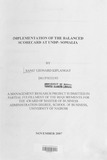| dc.description.abstract | Strategy implementation poses a great challenge to many organizations and determines
the success or failure of that strategy. A study done with selected top firms in the United
States of America revealed that less than ten percent of the strategies developed were
effectively implemented. The success of a strategy therefore is not on how good a
strategy has been crafted but how effectively that strategy has been implemented.
The Balanced Scorecard (BSC), developed by Robert Kaplan and David Norton in the
early 1990's has been adopted by various organizations globally. Initially developed as a
performance management tool, many organizations upon adopting it, found it to be very
useful in terms of translating strategy into short-term objectives and measures. The BSC,
as developed was to address the weakness that existed with the sole reliance of financial
performance measures. This was by bringing in three additional measures-customer,
internal business processes, learning and growth which together with financial, make the
four BSC perspectives.
The United Nations Development Programme (UNDP) was among the first public sector
organizations to adopt the BSC, and it was introduced in the year 2001. This study sought
to establish how the implementation of the BSC has contributed to success in strategy
implementation. This was by looking into the reasons why UNDP adopted the BSC, its
implementation and the outcomes at UNDP Somalia with an appreciation of its
implementation globally.
The study was carried out as a case study to allow for in-depth examination and analysis
of various data collected. Primary data was obtained through interviews and discussions
with key personnel at UNDP Somalia, Kenya and Corporate planning unit in New York
with the help of a pre-prepared interview guide. Secondary data was obtained in the form
of relevant documented materials on the BSC, strategy papers, in-house publications
among other materials. The data, obtained in qualitative form was analyzed through
content analysis. This approach helps in getting areas of consensus and disagreement
from various interviews done and the already documented data. The study revealed that the BSe was introduced to UNDP for planning, communicating
and monitoring with an intention to create a balance between the daily operations and
long-term strategic goals. Success has so far been noted since it was adopted through its
use to formulate measurable targets on various indicators falling under different strategic
objectives. These strategic objectives fall under five BSe perspectives-client (customer),
financial resources, internal efficiency, learning and growth and programme quality. The
later was added to the BSe perspective with the aim of improving quality of programmes
being run by the UNDP.The strategic objectives are derived from UNDP strategic planthe
Multi- Year Funding Framework (MYFF). With the measurable targets, the
headquarters is able to monitor performance of various country offices, and there is better
planning, improved communication and motivation among staff. The process is not yet
concluded and UNDP continues to improve its BSe with each new MYFF.
UNDP needs to build up on successes achieved with BSe implementation through
cascading it to all levels of the organization, training and educating staff on the BSe so
that they have a better understanding of their day-to day work versus strategic objectives,
and to be in a better position to use the BSe generated information. Lack of awareness
about the BSe amongst various staff was noted, which was a limiting factor as it was not
possible to get as many views as possible. With staff turnover, it was not possible to get
the views of some of the staff who were there during the introduction and
implementation.
The study focused on an international organization as a case study. More case studies
could be carried out on local entities that have implemented the BSe, as these would be
helpful to those organizations intending to implement the BSe in the local Kenya
scenario. | en |

